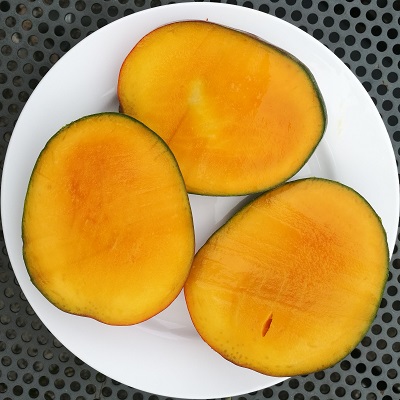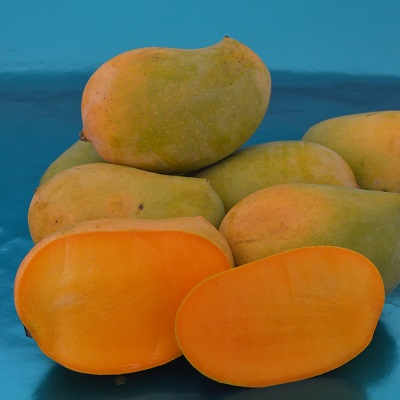Fruit Type:
Mango
Description:
Family: Anacardiacae
Latin names:
- Mango – Mangifera indica L.
Related fruit types (there are 49 Mangifera spp.):
- Water mango – Mangifera laurina
- Forest mango – Mangifera sylvatica
- Kasturi or Kalimantan mango – Mangifera casturi
Anacardiacae (the Sumac family) includes poison ivy, cashew, pistachio, dragon plum, kaffir plum, Jamaica plum, mombin, imbu, ambarella, gandaria and bauno.
Mangoes are the fruit of an evergreen tree.
The tree is long-living with a deep tap root, erect in stature, and generally 10-40m tall.
The leaves are dark green, alternate, simple, shiny and a narrow oval shape (lanceolate). There are generally one or two growth flushes per year. The leaves can smell of turpentine, and contain large amounts of mangiferin, a glucosylxanthone (a bioactive compound thought to offer protection against a range on cancers (*M Imran et al).
The flowers develop on a pyramidal panicle, with up to 6000 flowers per panicle. The fruit are set from hermaphroditic flowers. Mango trees are self-fertile, but pollinating insects are important for fruit set. Pollination is limited by low temperatures and heavy rain.
Mangoes are drupe fruit.
They have a tough, smooth skin, a sweet, fleshy edible portion and a compressed, ribbed stone with a single seed. Shape varies from plump and round to long, slender and sculptured, often with a characteristic ‘nose’, while the skin is smooth, sometimes silky smooth, and thin or very thin.
Mangoes are climacteric fruit.
Ethylene production by mangoes is moderate.
Ethylene sensitivity in mangoes is high.
History:
Mangifera indica originated in the Indo-Burma region of South-East Asia in the foothills of the Himalayas and has been recorded as long ago as 4000BC. It has been cultivated in India for 4000 to 6000 years and has spread to all tropical and sub-tropical climatic zones. From India, mangoes spread to China by the 7th century, then in 10th century to East Africa, 15th century to Philippines and SE Asia, 16th century to Brazil and Jamaica, 17th century to Hawaii and 19th century to North America.
Mangoes are part of the cultural heritage of India, a symbol of love, and Kadpavriksha, the wish-granting tree (*Yadav+Singh).
Variety development has generally taken place over centuries in South and South-East Asia, with a large concentration of varieties in Malaysia and Indonesia. Many commonly trade varieties were bred in Florida in the early 20th century, while Israel has proved to be a successful and more recent source of interesting new cultivars.
Grown in:
Mangoes are grown across the globe in tropical and sub-tropical climatic zones that are frost-free:
Central & South America, Hawaii and Florida; the Caribbean; Africa; South and South-East Asia; China and Taiwan; Israel, Italy (Sicily) and Spain; Australia.
Seasons and Sources:
Mangoes have distinct periods of production through the year, even in equatorial areas where day-length barely changes. In these areas, the flowering and fruiting is influenced mainly by timing of rainy seasons, but production can be spread over many months. In the sub-tropical zones, where a distinct winter/summer cycle is experienced, mangoes are harvested in the autumn.
Sources of mangoes for the UK are mainly from:
- Peru, Brazil, Columbia, Ecuador, Dominican Republic, Puerto Rica, Costa Rica, Mexico
- Ghana, Cote d’Ivoire, Burkina Faso, Mali, Gambia, Senegal
- Israel, Spain, Egypt;
- India, Pakistan, Bangladesh, Thailand, Philippines.
The main supply seasons of mangoes for UK markets are:
- December to March: Peru, Brazil
- April: Peru, Brazil, Mexico, India
- May / June: West Africa, Central America, Caribbean, India, Pakistan
- July: West Africa, Central America, Caribbean, Pakistan
- August: West Africa, Central America, Caribbean, Pakistan, Israel, Egypt
- September / October: Spain, Israel, Egypt, Caribbean, Brazil
- November: Caribbean, Brazil
Storage and Storage Potential:
- Temperature: 8-13oC
- Time: 1-4 weeks
- Atmosphere: 5%-8% CO2; 3%-7% O2
Main problems in storage: Altenaria black spot, Anthracnose, Bacterial black spot, Bacterial rot, Black mould rot, chilling injury, internal breakdown, Powdery mildew, Soft nose, Stem-end breakdown, Stem-end rot. (Source: https://www.cargohandbook.com)
The storage-life of mangoes is very dependent on the variety. Many of the varieties from South and SE Asia ripen quickly and need to be consumed within 2-3 weeks of harvest, even with cold storage. These varieties tend to be more susceptible to chill damage and more prone to internal disorders. It is most common for these varieties to be exported by airfreight, but consumers are willing to pay higher prices because the varieties have a superior flavour.
On the other hand, the range of varieties most commonly sold in supermarkets (e.g. the ‘Florida’ cvs – Kent and Keitt) have good storage potential of up to 5 weeks and are less sensitive to the effects of cold storage temperatures. Providing they are harvested at the correct maturity and have the field heat removed quickly, these can be exported by sea-freight from as far away as Peru, which allows the fruit to be sold at lower prices on the export markets. The compromise associated with lower cost sea-freighted mangoes is less flavour in the ripe fruit: a function of the varieties themselves, as well as early harvest to enhance storage time.
Storage at Home:
Mangoes should not be kept in the fridge at home. The only exception is for fully ripe mangoes which will keep for a short period, though are best eaten instead of stored.
Mangoes should be stored at room temperature and monitored for softening before eating. Some varieties, such as Kent and Keitt, can remain firm for a week or more, while most Asian varieties will need eating within a few days of purchase. Mangoes are remarkably resilient, though, and most will remain edible even after the skin becomes rather shriveled in appearance following a lengthy spell in the fruit bowl.
In very cold winter months, if the room temperature drops below 10 or 12oC at night, some sensitive varieties of mango may suffer chill damage and flesh discolouration in the fruit bowl (as would bananas).
Methods of Distribution:
Mangoes are transported in cardboard cartons, sometimes with additional padding to prevent bruising. Sea freight is in refrigerated containers at 8 to 13oC, often with a modified atmosphere. Airfreight mangoes are usually held at ambient temperatures for the journey but protected from excess cold or heat.
Characteristics and What to Expect:
Worldwide, mangoes are one of the most popular and sought-after fruit. The ample flesh is sweet and, often, wonderfully flavoursome, and they provide a depth of indulgence that is very alluring. Smooth skinned, plump, and pleasingly shaped, a good mango is hard to beat. The stone is slim and centred, making it easy to slice-off the fleshy cheeks. The variations between varieties are about shape, skin thickness, aroma, flavour, fleshiness and fibre (see section of varieties).
Some older varieties have fibres attached to the stone and suffusing the flesh, which can get between the teeth. Old varieties can also have a hint of turpentine in the flavour which many people find unattractive. These are very unlikely to be exported but may be available in local markets of producing countries. A few commonly available varieties have minor amounts of fibre, e.g. Palmer, Osteen, but mostly, the varieties on sale in supermarkets are essentially fibreless to mouth feel.
Flavour is the main differentiator in variety choice. The most flavoursome mangoes tend to be from south and south-east Asia with those from India and Pakistan being most common in UK. Most producing countries have their own examples of popular, flavoursome varieties which may be available in independent stores, if not UK supermarkets. Most of these flavoursome varieties have existed for centuries, perhaps seeing gradual improvement through local selection, and they can have minor detractions such as thick stones, plain external colouration or propensity to disorders such as spongy flesh. However, flavour usually trumps all, and, in addition, these mangoes tend to have a wonderful aroma that is irresistibly enticing.
The mangoes that are generally offered for sale in supermarkets, e.g. Kent, Keitt, Palmer, Haden, are characterised by fleshiness, slightly thicker skin, sweetness, and, often, red or orange blushed peel. Expect these to be sweet and juicy, but with minimal flavour and aroma. Actually, if left on the tree to ripen fully, these varieties do have flavour, but they would not then stand the sea journey, which is the compromise we make to have affordable mangoes in our supermarkets all year round.
From the best of the more premium mangoes, expect luscious flavour, aroma, juice, sweetness and a strong desire to eat more.
At worst, mangoes are inedible because of discolouration of the flesh, breakdown and decay, spongy flesh, poor ripening, or insipid taste. Often such issues are linked to fruit being harvested too early, poor temperature control in distribution, or being held too long in storage. The disappointment is keenly felt as internal issues are not visible until the mango is being prepared for eating.
Benefits:
Aside from being one of the most attractive and satisfying of fruit, mangoes don’t stand-out particularly against other fruit for nutritional content. However, mangoes are relatively high in energy and sugar, they are a good source of vitamins, particularly C and A, and are rich in polyphenols.
- Energy: 65kcal/100g
- Sugars: 15% of content, of which sucrose = 51%; fructose = 34%
- Vit. C: 46% dv/serving
- Vit. A: 15% dv/serving
Regular consumption makes available to the body several interesting polyphenols, not least mangifera, which may confer beneficial antioxidant effects. The fruit can also help reduce glucose levels in the blood; possibly help lower the risk of developing type 2 diabetes, and guards against overeating when included at the beginning of a meal.
A single unripe mango is generally good value for money, so buying a regular supply to ripen in the fruit bowl is a very enjoyable way of exposing our bodies to a food whose beneficial effects could be ever-present, and possibly accumulative, in our lives: regular consumption is beneficial.
Risks:
Mangoes are in the same family, Anacardiacae, as Poison Ivy, which is known to cause skin irritation to some people in the form of a red itchy rash. The compound responsible, urushiol, is also present in mango peel, leaves and bark, though to a much lesser extent than Poison Ivy. For people who are particularly sensitive, contact with mango peel may therefore cause mild skin irritation.
How to Buy:
Mangoes in supermarkets are sold loose, either ready to eat or for home ripening; in twin ‘ripe & ready’ packs; in ‘value’ packs or nets; or in small cartons of premium varieties.
- Be aware of the current mango season to avoid very early or end-of-season fruit.
- Mid to late season fruit are more reliable for ripening and taste than early season fruit.
- Often, twin ‘ripe & ready’ packs in supermarkets contain one ripe mango and one less ripe mango, which sometimes never matures properly – very annoying and rather expensive. Buy twin packs with caution by looking for two evenly ripe fruit in the pack or buy single fruit and leave enough time for them to ripen in the fruit bowl.
- Don’t be swayed too much by pink, purple or red colouration of the peel as the blush has little baring on the mango’s maturity.
- If you need to buy a ripe mango for immediate use, it is important to gently feel the fruit to assess its tenderness by pressing softly with thumb and fingers. Assessing ripeness through touch is not an exact science, but hard mangoes are not ready to eat, while firm mangoes with a little ‘give’ are probably still immature. Look for sufficient ‘give’ to convey a sense of juiciness and succulence without being too soft.
- Premium mangoes, for example from India, Pakistan and Thailand, are air-freighted in a state of more advanced maturity and are usually ready to eat on purchase. They also have very thin peel which makes it easier to detect the succulence of the flesh. Varieties such as Ataulfo from Mexico (and Brazil) are also in this category, if air-freighted.
Maturity and Ripening:
The task of harvesting a mango, for example in Peru, to cope with a long 3-to-4-week journey to market by sea and land, which will then ripen perfectly in the expectant customer’s fruit bowl, is not easy. The same can be said for all climacteric fruit that are transported around the world by sea, so the ability of the retailer to select skilled growers and suppliers is crucial. Find a retailer that you trust!
Best Time to Buy in UK:
Mangoes are available all year round in UK retail outlets, however, stand-out months for mangoes are March/April, May and August/September:
May: The peak of the Indian and Pakistani seasons, plus good supply from Caribbean, central and south America. Mexican Ataulfo is also available as a premium fruit through to early July, and more reliable than supplies available in late March/April.
August/September: The Israeli season hits its stride, Spanish mangoes build in volumes, and there are settled, later-season supplies from Caribbean and west Africa.
March/early April: These months are notable for the quality of Kent and Keitt from Peru which are at their best with fruit that is harvested later in the season, so more mature and reliable (and tasty).
Best Varieties to Buy:
Main premium varieties sold in UK supermarkets:
- Ataulfo: (from Mexico, Brazil)
- Aya, Maya, Shelley, Kasturi: (from Israel)
- Nam Dok Mae: (from Thailand)
- Kesar: (from India)
Main premium varieties sold in UK independent stores:
- Ataulfo: (from Mexico, Brazil)
- Nam Dok Mae: (from Thailand)
- Alphonse: (from India)
- Kesar: (from India)
- Sindhri: (from Pakistan)
- Chaunsa: (from Pakistan)
Main standard varieties sold in UK supermarket and independent stores:
- Kent: (from American, African, Caribbean and Mediterranean sources)
- Keitt: (from American, African, Caribbean and Mediterranean sources)
- Palmer: (from Brazil)
How to Use:
The most enjoyable way to eat a mango is cut off the two fleshy sides of the stone, run a knife across the flesh, both ways, without cutting through the peel, then scooping out the flesh with a spoon from the natural bowl that is formed. Alternatively, for an indulgent though more messy approach, the natural bowl can be pushed inside-out and the squares of flesh eaten directly as they protrude, hedgehog-like, from the peel.
With a sharp knife, remove the peel from the remaining central piece and nibble the flesh around the stone.
Keeping a good mango as the centre piece of a dish should be the aim. So the next best option is to serve it simply combined with a slightly more acidic fruit such as raspberries. It is more elegant to prepare the flesh for such a dish by creating long strips rather than the bulky squares, which contrast beautifully with the raspberries. Some of the thin-skinned premium varieties are easy to peel with a sharp knife, leaving the whole fruit to be cut through the flesh length-ways, all around and perpendicular to the stone. The flesh can then be sliced away in long strips by cutting flat against the stone with the knife.
Mango also makes a great base for any good fruit salad, which needs a bulky, sweet fruit (banana, pineapple, papaya or melon are alternatives) to balance the other components.
Other ways to use mangoes are numerous and there are plenty of recipes, particularly for desserts and drinks, that make use of them. Perhaps the most famous recipe is mango and sticky rice, beloved in south-east Asia, particularly Thailand, where the delicious Nam Dok Mae is often used over a bed of sweet, coconut infused pudding rice.
Quality Issues at Home:
In some ways, mangoes are quite robust and forgiving fruit and often will still be enjoyable, even if forgotten in the fruit bowl for a while. Most quality issues, other than those creating by storing unripe mangoes in the fridge or due to very cold winter nights, are caused before the fruit arrives in our home fruit bowl.
The most annoying issues are those of maturity whereby the mango is effectively inedible due to lack of flavour, sweetness and juice, or because of internal discolouration. These issues are immensely frustrating for the trusting customer and are usually caused by manageable issues such as fruit being harvested too early; being held too long in cold storage or at too low a temperature.
Various bacterial or fungal diseases may affect mangoes once they are at home in the fruit bowl, but retailers with good suppliers will usually be able to screen these out before they go on sale. The most common in mangoes bought from supermarkets is a stem-end rot that starts at the stalk-end and advances further into and across the fruit. Sometimes the rot starts while still on the retail shelf, so avoid any fruit with any signs of blackening at the stalk. If it is detected at home and the fruit is ripe, it is possible to cut the affected flesh away and still eat the mango.
Other internal issues include Spongy tissue, which looks like a die-back or breakdown of the flesh near the stone, and is associated with varieties such as Alphonse and Kesar from India. This is a disorder caused by complex imbalance of fatty acids as the fruit matures on the tree. It is unpleasant, but cannot be detected through external inspection of the fruit, only through impractical methods such as x-ray (S Shivashankar + M Sumathi).
©Good Fruit Guide 2023. Recommendations on fruit varieties and types with the very best taste are personal to the editor of Good Fruit Guide, and do not attempt to be exhaustive or supported by verifiable consumer research. The highlighting of fruit with the very best taste in the opinion of the editor is not intended as a judgement on the taste of varieties and types of fruit not mentioned.



